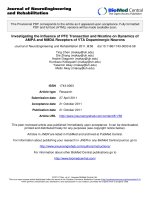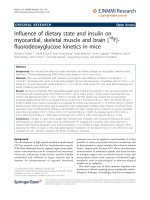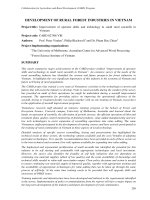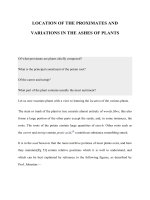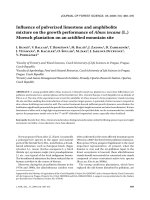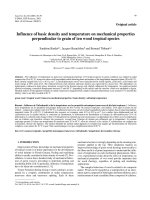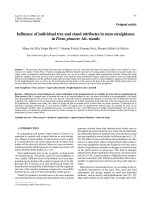Influence of stubble height and nitrogen fertilizer level on seed yield and quality in KRH-4 hybrid rice seed production
Bạn đang xem bản rút gọn của tài liệu. Xem và tải ngay bản đầy đủ của tài liệu tại đây (245.33 KB, 8 trang )
Int.J.Curr.Microbiol.App.Sci (2019) 8(4): 435-442
International Journal of Current Microbiology and Applied Sciences
ISSN: 2319-7706 Volume 8 Number 04 (2019)
Journal homepage:
Original Research Article
/>
Influence of Stubble Height and Nitrogen Fertilizer Level on Seed Yield and
Quality in KRH-4 Hybrid Rice Seed Production
Madhukeshwara B. Puttappanavara* and V.K. Deshpande
Department of Seed Science and Technology, College of Agriculture, University of
Agricultural Sciences, Dharwad, Karnataka State (India)-580005
*Corresponding author
ABSTRACT
Keywords
Stubble height,
Ratooning,
Nitrogen, Hybrid
Article Info
Accepted:
04 March 2019
Available Online:
10 April 2019
A field experiment was carried out during rabi 2016 and 2017 at the Agricultural Research
Station, Malagi, UAS, Dharwad to study the influence of stubble height and nitrogen
fertilizer level on ratoon seed yield in KRH-4 hybrid rice seed production. The experiment
consisted of two factors. Factor one was the stubble height which included 3 cutting
heights namely H1: (15 cm A line and 15 cm R line), H2: (15 cm A line and 20 cm R line)
and H3: (20 cm A line and 20 cm R line). Factor two was the nitrogen fertilizer levels viz.,
F1: (25% N of main crop), F2: (50% N of main crop), F3: (75% N of main crop) and F4:
(100% N of main crop) and the treatment combinations were replicated thrice. The results
revealed that among the stubble heights H3 recorded the highest regeneration percentage
(98.89 % and 98.67 % in 2016 and 2017 respectively), highest plant height (45.54 cm and
46.54 cm in 2016 and 2017 respectively), whereas the highest seed set (8.47% and 8.68%
in 2016 and 2017 respectively) and seed yield per hectare (375 kg and 425 kg in 2016 and
2017 respectively) recorded by H2. Among the nitrogen levels F4 recorded the highest
regeneration (97.49% and 97.53% in 2016 and 2017 respectively) and highest plant height
(44.50 cm and 45.61 cm in 2016 and 2017 respectively) whereas the F 3 recorded highest
seed yield per hectare (395 kg and 450 kg in 2016 and 2017 respectively). Among the
combinations H2F3 recorded the highest seed yield per hectare (449 kg and 502 kg in 2016
and 2017 respectively) due to effective synchrony of flowering between the parental lines.
The study indicated that stubble height at H2:(15 cm A line and 20 cm R line) together with
nitrogen fertilizer level of F3: (75% N of main crop) is ideal in achieving the better
synchrony of flowering as well as better regeneration of ratoon to get higher seed yield in
KRH-4 hybrid rice.
main-crop harvest. The ratoon crop develops
by regenerating rice tillers from nodal buds of
the stubble that was left behind after the first
seasonal rice harvest. The practice of
ratooning can be followed by the farmers for
the purpose of on farm seed production which
Introduction
Rice (Oryza sativa L.) is the staple food for
nearly fifty per cent of the world’s population.
Rice ratooning is the production of a second
rice crop from the stubble left behind after the
435
Int.J.Curr.Microbiol.App.Sci (2019) 8(4): 435-442
ensures cent per cent genetic purity in seed
production activity as the ratoons are
generated vegetatively. Grain yield of the
ratoon crop is generally one-third of the yield
realized in the first, or main, crop (Turner and
Jund, 1993). Main-crop harvest heights are
cultivar dependent and generally range
between 40 and 45 cm above ground level.
Lower harvest heights leaving stubble of 20–
25 cm are currently recommended in Texas as
a potential ratoon yield enhancement strategy
when the main crop is harvested before
August 15 (Tarpley et al., 2008). The
advantage of rice ratooning is that in areas
where rice is the main crop, a double crop of
rice can be grown for additional returns. The
ratoon crop matures earlier and requires less
labor and water inputs (Reddy et al, 1979).
Rice ratooning offers special scope for
increasing production without expanding land
area, particularly where moisture and growing
season are inadequate for planting a second
crop of rice. The practice of ratooning in
hybrid rice ensures the cent per cent of
genetic purity in hybrid rice seed production
as the ratooning involves the vegetative
propagation of parental lines through the left
over stubbles. Seed production from the
ratoon crop may thus be possible. Planting
value and stability of ratoon crop seed are
worth studying to determine the seed
production potential. In case of scarcity of
parental seeds and human resource F1 seed
production can be made possible with small
alterations in agronomic practices to obtain
considerable quantity of F1 seeds within short
span of time with least effort. This practice
also reduces burden of rouging, weeding,
isolation maintenance which have been taken
care of during main crop only. Hence the
effort was made to realize the importance of
technique.
Dharwad during rabi 2016 and 2017 to
standardize the technique of hybrid rice seed
production through ratooning of parental lines
in KRH-4 hybrid rice. The experiment was
laid out in randomized block design with 2
factors viz., factor one consisted of the height
of stubble cutting (H1): 15 cm A line and 15
cm R line, (H2): 15 cm A line and 20 cm R
line, (H3): 20 cm A line and 20 cm R line and
factor two was the nitrogen fertilizer levels.
(N1): 25% N of main crop RDF, (N2): 50% N
of main crop RDF, (N3): 75% N of main crop
RDF, (N4): 100% N of main crop RDF and
replicated thrice. The resultant seed quality
attributes were examined in the laboratory of
Department of Seed Science and Technology,
College of Agriculture, UAS, Dharwad. The
parental seeds, CRMS 32-A (male sterile line)
and MSN 36-R (Restorer line) of KRH-4
hybrid rice were collected from the Zonal
Agricultural Research Station, Mandya. The
ratooning (stubble cutting) of parental lines
treatments were imposed at harvest maturity
stage and the nitrogen fertilizer treatments
were imposed immediately after the main
crop harvest in each plots as per the
treatments. The five randomly selected and
tagged plants from the net plot were used to
record the observations. Observations on
plant height (cm), regeneration percentage,
number of tillers and yield parameters like
number of productive tillers, panicle length
(cm), seed set (%) and seed yield plant-1 (g)
were recorded. The data recorded were
subjected to the statistical analysis as per
Panse and Sukhatme.
Results and Discussion
Studies on influence of stubble height and
nitrogen levels exhibited the significant
variations on growth, flowering and yield
parameters in KRH-4 hybrid seed production
by ratooning of parental lines. Among the
treatments of height of stubble cutting, the
higher stubble heights (H3): 20 cm in A line
and 20 cm in R line recorded the significantly
Materials and Methods
The field experiment was carried out at the
Agricultural Research Station Malagi, UAS,
436
Int.J.Curr.Microbiol.App.Sci (2019) 8(4): 435-442
higher growth parameters like regeneration
percentage (98.89 % and 98.67 % in 2016 and
2017 respectively), highest plant height
(45.54 cm and 46.54 cm in 2016 and 2017
respectively), least number of days to 50 per
cent flowering (42.75 and 43.92 days in 2016
and 2017 respectively), highest number of
tillers (7.31 and 8.57 in 2016 and 2017
respectively), similarly among the yield
parameters, the higher number of productive
tillers (5.08 and 6.30 in 2016 and 2017
respectively) was noticed with H3, whereas
higher seed set per cent (8.47 % and 8.68 %
in 2016 and 2017 respectively) and seed yield
per hectare (375 kg and 425 kg in 2016 and
2017 respectively) were registered with
stubble height H3.
recorded significantly highest plant height
(46.17 cm and 46.83 cm in 2016 and 2017
respectively),
H3F3
interaction
took
significantly least number of days for 50 per
cent flowering (42.33 and 43.67 days in 2016
and 2017 respectively), whereas the treatment
combination of H2F3 registered the highest
seed yield per hectare (449 kg and 502 kg in
2016 and 2017 respectively).
Though the genotypic difference exists for the
growth, performance and ratooning ability,
the success of ratoon crop also depends on the
agronomic practices like height of cutting,
time of cutting, water and fertilizer
management with care of plant protection. So
in the present investigation also the ratooning
practices like height of cutting and nitrogen
levels vitally influence the ratoon growth and
performance. The cutting height of parental
lines significantly influenced the growth
parameters. Among the treatments, the cutting
height H3: 20 cm in A line and 20 cm in R
line recorded the highest regeneration per
cent, highest plant height, least number of
days 50 per cent flowering and highest
number tillers compared to other stubble
cutting heights. Wide variation exists among
rice cultivars in their genetic potential for
ratooning and yield levels. On an average,
ratoon rice can give a yield roughly
equivalent to 40 per cent that of the main
crop, with 40 per cent reduction in crop
duration. The increase in the plant height and
number of tillers as well as earliness in the
flowering is mainly because of higher
carbohydrates that remain in the stubbles and
roots (Mahadevappa and Yogeesha, 1988) in
longer stubbles after the harvest of the main
crop and rapid senescence of leaves in the
shorter cutting heights of stubbles. Bahar and
Datta (1977) observed 15-20 cm as the
optimum cutting height above ground. The
present findings are similar with the reports of
Mortaza et al., (2011) in rice; Petroudi et al.,
(2011) in rice.
The nitrogen levels imparted the remarkable
variations on growth, flowering and yield
parameters. Among the treatments of nitrogen
levels, the nitrogen dosage of 100% of the
main crop (F4) registered the significantly
higher growth parameters like regeneration
percentage (97.49 % and 97.53 % in 2016 and
2017 respectively), highest plant height
(44.50 cm and 45.61 cm in 2016 and 2017
respectively), whereas the least number of
days to 50 per cent flowering (42.78 and
44.00 days in 2016 and 2017 respectively)
was observed in the plants given with the
75% nitrogen of the main crop (F3), similarly
the nitrogen dose (F3): 75 per cent nitrogen of
main crop recorded the highest number of
tillers (7.43 and 8.72 in 2016 and 2017
respectively), the higher number of
productive tillers (5.08 and 6.30 in 2016 and
2017 respectively), seed set per cent (8.37 %
and 8.63 % in 2016 and 2017 respectively)
and seed yield per hectare (395 kg and 450 kg
in 2016 and 2017 respectively).
The interaction effects were found nonsignificant for the regeneration percentage,
number of tillers and seed set percent
however the treatment combination of H3F4
437
Int.J.Curr.Microbiol.App.Sci (2019) 8(4): 435-442
Among the level of nitrogen fertilizers,
application of 100 per cent nitrogen of main
crop RDF (F4) recorded the significantly
highest regeneration per cent, accordingly
highest plant height, whereas F3 recorded the
higher number of tillers, least number of days
to 50 % flowering. The higher dosage of
nitrogen fertilizer increased N metabolism,
delayed leaf senescence and promoted
germination of dormant buds. Although
ratoon tiller development is determined by
genotype and a number of management and
environmental factors, Chauhan et al., (1985)
and Ichii (1984) showed the effectiveness of
nitrogen element in promoting development
and growth of ratoon tillers. However the
higher dose of nitrogen promotes the
vegetative growth and delays the flowering.
Similar results were also reported by Ali et
al., (2011) in rice and Endris and Alemayehu
(2014) in rice.
be due to the better synchrony of flowering
between parental ratoons ensuring the
effective crossing, higher seed set and seed
yield compared to other cutting heights. The
height of cutting affects the days to panicle
emergence
and
days
to
flowering
(Mahadevappa and Yogeesha, 1988; Santos et
al., 2003) as the synchrony of parental lines is
the key for success in hybrid seed production
the differential cutting height of 15 cm in the
seed parent and 20 cm in the pollen parent
facilitated the better synchrony together with
optimum height for the better regeneration.
Application of 75% of nitrogen of main crop
registered the higher yield parameters
compared to other doses of nitrogen.
Availability of nitrogen to the left over
stubbles just after removing main crop plant
tops is important in harnessing the reserve
carbohydrates accumulated in stem bases, and
eventually in the better growth and
development of the ratoon plant.
Ratooning in rice offers special scope for
boosting the production without expanding
land area, particularly where moisture and
growing season are inadequate for planting a
second crop of rice. The ratoon yield varies
26 % to 350 % of the main crop, but on an
average the ratoon yield roughly equivalent to
40 % that of the main crop depending upon
the management practices (Chauhan, 1988).
In the present study also the ratooning
practices in hybrid rice seed production
exigently influenced the ratoon yield and
yield parameters.
The higher doses of nitrogen negatively affect
the mobilization of carbohydrate reserves of
ratoon rice causing delay in the duration for
flowering, maturity and weakening of the
plants which may adversely affect the
performance and yield of the ratoon rice.
Similar results were given by Evatt and
Beachell (1960) who recommended that
application of 75 per cent nitrogen of main
crop as the optimum nitrogen dosage for
higher yield of ratoon. The present research
findings are in agreement with the findings of
Hiroshi and Satoshi (2008) in rice and Ali et
al., (2011). The significantly increased yield
in H2F3 might be due to the effective
synchrony achieved with differential cutting
heights of parental lines (Mahadevappa and
Yogeesha, 1988) as well as the increased
yield attributing characters in the ratoon
plants imposed with cutting height of 15 cm
in A line and 20 cm in R line together with
optimum dosage on nitrogen fertilizer of 75
per cent of main crop (Table 1–4).
The yield attributes such as number of
productive tillers, seed set per cent and seed
yield per hectare were found to be significant
for the cutting height. Though the cutting
height H3: 20 cm in A line and 20 cm in R
line recorded the highest number of
productive tillers, the cutting height H2: 15
cm in A line and 20 cm in R line registered
higher seed set per cent, seed yield per plant
and highest seed yield per hectare. This might
438
Int.J.Curr.Microbiol.App.Sci (2019) 8(4): 435-442
Table.1 Influence of stubble height and nitrogen application on regeneration per cent and plant height in seed parent (CRMS 32-A) of
KRH-4 hybrid rice
Treatments
F1
F2
F3
Regeneration per cent (2016)
Regeneration per cent (2017)
Plant height (cm) 2016
Plant height (cm) 2017
H1
H2
H3
Mean
H1
H2
H3
Mean
H1
H2
H3
Mean
H1
H2
H3
Mean
91.98
93.83
94.81
93.70
94.69
96.42
97.78
98.40
100.00
94.49
95.64
97.08
91.11
94.07
95.43
92.59
94.94
95.68
97.28
98.02
99.88
93.66
95.68
97.00
41.17
41.83
43.17
41.50
42.17
43.17
45.17
45.33
45.50
42.61
43.11
43.94
41.83
43.33
44.50
42.33
43.73
44.67
46.33
46.33
46.67
43.50
44.47
45.28
F4
Mean
96.05 97.04
94.17 95.46
S. Em. ±
99.38 97.49
98.89
CD (0.05)
96.30 96.79
94.23 95.00
S. Em. ±
99.51 97.53
98.67
CD (0.05)
43.83 43.50
42.50 42.58
S. Em. ±
46.17 44.50
45.54
CD (0.05)
45.00 45.00
43.67 43.93
S. Em. ±
46.83 45.61
46.54
CD (0.05)
F
0.68
2.00
0.65
1.92
0.15
0.45
0.21
0.61
H
F×H
0.59
1.18
1.73
NS
0.57
1.13
1.66
NS
0.13
0.27
0.39
0.78
0.18
0.36
0.53
1.06
Table.2 Influence of stubble height and nitrogen application on total tillers and productive tillers in seed parent (CRMS 32-A) of
KRH-4 hybrid rice
Treatments
F1
F2
F3
F4
Mean
Total tillers (2016)
H1
H2
H3 Mean
5.37 5.40 6.43 5.73
5.97 6.00 7.00 6.32
7.13 7.17 8.00 7.43
6.70 6.80 7.80 7.10
6.29 6.34 7.31
S. Em. ±
CD (0.05)
0.04
F
0.03
H
0.06
F×H
F: Nitrogen levels
F1: 25% N of main crop
F2: 50% N of main crop
F3: 75% N of main crop
F4: 100% N of main crop
NS: Non-significant
0.11
0.09
NS
Total tillers (2017)
H1
H2
H3 Mean
6.50 6.60 7.57 6.89
7.10 7.23 8.13 7.49
8.37 8.43 9.37 8.72
8.03 8.20 9.20 8.48
7.50 7.62 8.57
S. Em. ±
CD (0.05)
0.07
0.06
0.12
0.20
0.18
NS
439
Productive tillers (2016)
H1
H2
H3 Mean
3.53 3.53 4.33 3.80
4.10 4.20 4.93 4.41
5.07 5.17 5.67 5.30
4.40 4.60 5.40 4.80
4.28 4.38 5.08
S. Em. ±
CD (0.05)
0.13
0.11
0.22
Productive tillers (2017)
H1
H2
H3
Mean
4.67 4.73 5.53
4.98
5.23 5.20 6.20
5.54
6.33 6.43 6.80
6.52
5.67 5.83 6.67
6.06
5.48 5.55 6.30
S. Em. ±
CD (0.05)
0.38
0.11
0.33
0.10
NS
0.19
H: Height of cutting
H1:15 cm A line and 15 cm R line
H2:15 cm A line and 20 cm R line
H3:20 cm A line and 20 cm R line
0.33
0.28
NS
Int.J.Curr.Microbiol.App.Sci (2019) 8(4): 435-442
Table.3 Influence of stubble height and nitrogen application on days to 50% flowering and seed set per cent in seed parent (CRMS
32-A) of KRH-4 hybrid rice
Treatments
F1
F2
F3
F4
Mean
F
H
F×H
Days to 50% flowering
(2016)
H1
H2
H3
Mean
45.00 44.67 43.00 44.22
44.67 43.33 43.00 43.67
43.00 43.00 42.33 42.78
43.33 43.00 42.67 43.00
44.00 43.50 42.75
S. Em. ±
CD (0.05)
0.15
0.44
0.13
0.38
0.26
0.77
Days to 50% flowering
(2017)
H1
H2
H3
Mean
46.33 46.00 44.33 45.56
46.00 44.67 43.67 44.78
44.33 44.00 43.67 44.00
44.67 44.33 44.00 44.33
45.33 44.75 43.92
S. Em. ±
CD (0.05)
0.14
0.41
0.12
0.35
0.24
0.71
Seed set per cent 2016
H1
H2
7.06 7.84
7.57 8.18
7.98 9.00
7.73 8.86
7.59 8.47
S. Em. ±
0.07
0.06
0.12
Seed set per cent 2017
H3 Mean
7.24 7.38
7.71 7.82
8.13 8.37
8.12 8.24
7.80
CD (0.05)
0.21
0.18
NS
H1
H2
7.32 7.97
7.75 8.37
8.14 9.33
7.94 9.04
7.79 8.68
S. Em. ±
0.12
0.10
0.21
H3
Mean
7.33
7.54
7.87
8.00
8.42
8.63
8.30
8.43
7.98
CD (0.05)
0.35
0.30
NS
Table.4 Influence of stubble height and nitrogen application on F1 seed yield per plant and F1 seed yield per ha in
KRH-4 hybrid rice seed production
Treatments
F1
F2
Seed yield/plant (g) 2016
Seed yield/plant (g) 2017
Seed yield/ha (kg) 2016
H1
2.69
2.83
H1
3.00
3.15
H1
278
299
H2
3.04
3.15
H3
2.73
3.00
Mean
2.82
2.99
3.19 3.62 3.24 3.35
3.06 3.43 3.10 3.20
2.94 3.31 3.02
S. Em. ±
CD (0.05)
0.02
0.05
F
0.02
0.05
H
0.03
0.09
F×H
F: Nitrogen levels
F1: 25% N of main crop
F2: 50% N of main crop
F3: 75% N of main crop
F4: 100% N of main crop
NS: Non-significant
F3
F4
Mean
H2
3.37
3.43
3.50 3.96
3.37 3.71
3.26 3.62
S. Em. ±
0.02
0.01
0.03
H3
3.01
3.30
Mean
3.13
3.29
3.57 3.68
3.38 3.49
3.32
CD (0.05)
0.05
0.04
0.09
440
H2
302
321
H3
284
307
Mean
288
309
Seed yield/ha (kg) 2017
H1
330
349
H2
352
369
H3
332
359
Mean
338
359
355 449 381
417 502
430
395
450
355 430 378
411 477
425
388
438
322 375 337
377 425
387
S. Em. ±
CD (0.05)
S. Em. ±
CD (0.05)
5.93
17.40
5.84
17.13
5.14
15.06
5.06
14.83
10.27
30.13
10.11
29.66
H: Height of cutting
H1:15 cm A line and 15 cm R line
H2:15 cm A line and 20 cm R line
H3:20 cm A line and 20 cm R line
Int.J.Curr.Microbiol.App.Sci (2019) 8(4): 435-442
The improved yield attributing characters
such as productive tillers and higher seed set
due to optimum dosage of nitrogen level (75
% of main crop) accorded for the higher
yields in ratoon (Ganguli and Ralwani 1954).
The present findings are in agreement with
the findings of Evatt and Beachell (1960) in
rice; Votong (1975) in rice.
Newsl., 9(3):1-4.
Ganguli, B. D. and Ralwani, L. L., 1954,
Possibilities of growing ratoon crop of
paddy and increasing its yield under
irrigated conditions. Sci. Cult. 19(7):
350-351.
Hiroshi, N. and Satoshi, M., 2008, Effects of
time of first harvest, total amount of
nitrogen, and nitrogen application
method on total dry matter yield in
twice harvesting of rice. Field Crop
Res., 105(2): 40-47.
Ichii, M., 1984, Studies on the utility of
ratoon traits of rice as the indicator of
agronomic characters in breeding.
Agron. J., 69: 536-540.
Mahadevappa, M. and Yogeesha, H. S., 1988,
Rice ratooning: breeding, agronomic
practices, and seed production potential.
Oryza., 26: 32-36.
Mortaza, N., Hemmatollah, P. and Taghi, N.
N., 2011, Effect of level and time of
nitrogen fertilizer application and
cutting height on yield and yield
component of rice ratooning. Proc. The
Fourth Int. Iran Russia Conf., Iran, pp.
602-606.
Petroudi, E. R., Ghorban, N., Javad, M.,
Hamid, M. and Hamid, R. M., 2011,
Effects of nitrogen fertilization and rice
harvest height on agronomic yield
indices of ratoon rice–berseem clover
intercropping system. Asian J. Cr. Sci.,
5(5): 566-574
Reddy, T. G., Mahadevappa, M. and
Kulkarni, K. R., 1979, Ratoon cropping
of rainfed rice. Int. Rice Res. Newsl.,
4(5): 25-26.
Santos, A. B., Fageria, N. K. and Prabhu, A.
S., 2003, Rice ratooning management
practices for higher yields. Comm. Soil
Sci. Plant Anal., 34: 881–918
Tarpley, L., McCauley, G. N. and Jund, M.
F., 2008, Ratoon (second) crop
production. In: Texas Rice Production
Guidelines. Texas Agri. Life Res. Exten.
In conclusion, the present investigation
inferred that the practice of ratooning by
cutting the stubbles at the height of 15 cm in
female parent and 20 cm in male parent of
KRH-4 hybrid rice together with application
of 75% nitrogen dosage of main crop RDF is
ideal to get higher seed yield.
Acknowledgement
The authors are thankful to the University of
Agricultural Sciences, Dharwad (Karnataka),
India for providing the necessary funds and
facilities to undertake the present research
work under Staff Research Project.
References
Ali, H., Ebrahim, A. and Hamid, Z. D., 2011,
Management of cutting height and
nitrogen fertilizer rates on grain yield
and several attributes of ratoon rice
(Oryza sativa L.) in Iran. World Appl.
Sci. J., 15 (8): 1089-1094.
Bahar, F. A. and Datta, S. K., 1977, Prospects
of increasing tropical rice production
through ratooning. Agron. J., 69(4):
536-540.
Chauhan, J. S., 1988, Use of ratooning in
hybrid rice. Oryza., 26: 151-154.
Endris, Y. and Alemayehu, 2014, Effect of
nitrogen application on grain yield and
nitrogen efficiency of rice, Asian J.
Crop Sci., 6(3): 273-280
Evatt, N. S. and Beachell, H. M., 1960,
Ratoon cropping of short season rice
varieties in Texas. Int. Rice Comm.
441
Int.J.Curr.Microbiol.App.Sci (2019) 8(4): 435-442
Service, pp. 51-52.
Turner, F. T. and Jund, M. F., 1993, Rice
ratoon crop yield linked to main crop
stem carbohydrates. Crop Sci., 33: 150–
153.
Votong, V., 1975, The effect of time of
drainage and time of rewatering on the
yield of ratoon rice, M.Sc.(Agri.) Thesis.
Univ. Sydney, (Australia).
How to cite this article:
Madhukeshwara B. Puttappanavara and Deshpande, V.K. 2019. Influence of Stubble Height
and Nitrogen Fertilizer Level on Seed Yield and Quality in KRH-4 Hybrid Rice Seed
Production. Int.J.Curr.Microbiol.App.Sci. 8(04): 435-442.
doi: />
442

